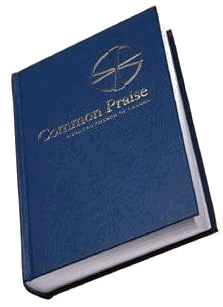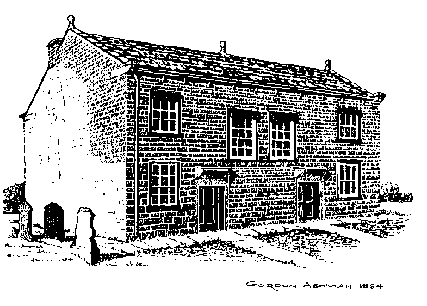THE LARKS OF DEAN QUIRE
Some time ago I wrote a piece concerning West
Gallery singing and music. Much of the interest shown in reviving this form of
church music was coming from the ‘folk’ movement. Dave Townsend, the guru of
such matters, lives in Oxfordshire and the new West Gallery groups which first
sprang up all seemed to be based in the southern part of the country. With time
the movement has spread further afield, as these things do. Now it is possible
to tell you of one such group here in Lancashire, and whose roots go deep into
the past. Not only that: you could quite easily go and listen to them, should
you so wish, and there may even be some people reading this who would fancy
having a go at singing or playing this kind of music.
As for putting together this article I should
like to place on record my sincere thanks for all the help and information
provided by Jean Seymour of Bury; to her I’m greatly indebted. Jean is both
secretary and conductor of the group, and for anyone looking to join the Quire
or to make a booking the ‘phone number is 0161 761 1544, or e-mail ajseymour@onetel.net
In this current year, when Charles Wesley’s te rcentenary
is being celebrated, it’s worth considering what became of his remarkable
output of close on nine thousand hymns. No one book could contain them all! In
fact, many of them remain in obscurity. Remember, too, that many have written
hymns and anthems; some of these people became widely known while others were
never heard of outside their own locality – and neither were their works.
Nevertheless, local choirs kept some of these works alive, and this is the story
of one such group of people.
rcentenary
is being celebrated, it’s worth considering what became of his remarkable
output of close on nine thousand hymns. No one book could contain them all! In
fact, many of them remain in obscurity. Remember, too, that many have written
hymns and anthems; some of these people became widely known while others were
never heard of outside their own locality – and neither were their works.
Nevertheless, local choirs kept some of these works alive, and this is the story
of one such group of people.
"Up in the Forest of Rossendale, between
Deerplay Moor and the wild hill called Swinshaw, there is a little, lone valley,
a green cup in the mountains, called Dean. The inhabitants of this valley are so
notable for their love of music that they are known all through the vales of
Rossendale as Th’Deign Layrocks, or The Larks of Dean."
These are the words of Lancashire author Edwin
Waugh, on the subject of the composers, singers and instrumentalists whose
activities in the Rossendale valley spanned the period between the 1740s and the
1860s.. By Waugh’s time, Rossendale was no longer the royal hunting ground
that ‘forest’ suggests. It was (and still is) made up of a large number of
small communities strung along the bottoms of the valleys. Cotton and
shoe-making became its main industries in Victorian times, but in the
mid-eighteenth century most people were handloom weavers – including the group
who became known as The Larks of Dean.
Early Information
Much came from the pens of the aforementioned
Edwin Waugh, and Lancashire historians Rev.J.Marshall Mather and Thomas
Newbigging, writing in the second half of the nineteenth century. All three
claimed acquaintance with actual members of the group, and certainly Newbigging
knew the music. He claimed to have a manuscript book of fifty tunes, which he
believed to be only a fraction of what existed. How right he was!
Later came a series of articles by Samuel
Compston of Crawshawbooth, published in the Rossendale Free Press between
September 1904 and January 1905. The inspiration for this was the presentation
of a manuscript book of 255 tunes to Rawtenstall library by Moses Heap, ‘the
last of the Layrocks’.
There are now fifty books preserved, many in
manuscript form. Most are now housed in the County Record Office in Preston,
with some still in private hands and half a dozen volumes – including a
transcript of Moses Heap’s diary - in Rawtenstall museum, together with a
cello, a fiddle, a clarinet and a serpent which once belonged to the players.
The Larks’ Beginnings
It all began with a sober young man, John Nuttall
of Bacup, who, with another of like mind, Richard Hudson of Loveclough, followed
the example of John Wesley and other itinerant preachers by going about on
horseback preaching, teaching and singing the new religious music that was
gaining favour. (Nuttall was mainly responsible for the religion and Hudson for
the music.)They happened to be Baptists, and it was in the Baptist Chapels of
Rossendale that most of the music of The Larks of Dean was kept alive – and
where some can still be heard, upon occasion, even today.
Nuttall and Hudson both regarded music as playing
an important part in religion and they gathered about them players and singers
to help focus the religious fervour. They married two sisters, both reputed to
have been excellent singers. Nuttall settled in the Lumb area; he held religious
meetings in houses and farms around Dean, and he began to teach music. This led
to the formation of a musical club in 1742 – generally regarded as the
beginning of The Larks of Dean, with John Nuttall as the founding father,
although this possibly underestimates the part played by Richard Hudson.
The names of various composers from the Nuttall
and Hudson families constantly crop up, as do those of Ashworth and Hargreaves.
There’s a large number of manuscripts from the Greenwood family too, although
they don’t seem to have actually done any composing.
Chapels and Music
As a result of these activities a small Baptist
chapel was built around 1750, next to Lumb parish church, and John Nuttall
became its first Minister. The local worshippers soon outgrew these premises and
in 1860 a new chapel was built on top of the moors at Goodshaw, which was deemed
to be a more central location, and The Larks transported their instruments over
the rough moorland terrain every Sunday to perform in the singing pew there. (It’s
perhaps worth pointing out that here, as in many other Baptist chapels, the
musicians’ pew was not in a west gallery but at floor level, directly in front
of the central pulpit and under the eye of the preacher. None of your Under
the Greenwood Tree goings-on in Rossendale!)
Many tales are told of the splendid music that
used to be a feature of the services at Goodshaw. It was even said that it could
be heard on top of Cribden, a hill-top two miles away!
Coincidentally, Goodshaw Chapel lasted as long as
The Larks of Dean: when it closed in 1860 in favour of the present chapel on the
main Bunley road, the heyday of The Larks was also passing. Today the Goodshaw
Old Chapel with its box pews, high central pulpit and, of course, the singing
pew, belongs to English Heritage and can be visited by arrangement.
When not performing their own music, The Larks of
Dean were very partial to that of Handel. However, robust singing in the local
accent caused one conductor to declare that if the choir didn’t stop singing,
"He thrusted in God," in the ‘Messiah’ chorus, they would be
thrust outside! Similarly, who but a local – with his droll sense of humour -
would have entitled a composition ‘The Gas Homiter March’?! (Probably
written to mark the construction of the gasholders, or gasometers, at Cloughfold.)
The new chapel still celebrates the anniversary
of the old one – currently on the first Sunday in July – with an afternoon
service in the graveyard of the old chapel. In the evening, again in the old
chapel, an all-comers’ choir joins in a set service which includes two
choruses from Handel’s ‘Messiah’; a tune called ‘Nearer Home’ by
J.B.Woodbury; Moses Heap’s ‘Ramah’, and three tunes from The Larks of Dean
collection: ‘Courage’ (Joseph Nicholds), ‘Spanking Rodger’ (James
Nuttall) and ‘Farewell’ (Rev.Joseph Harbottle).
Roy
Smith
to
be continued in the next issue
Also have a look at www.larksofdean.co.uk/
and www.wgma.org.uk/Articles/Larks/article.htm
 rcentenary
is being celebrated, it’s worth considering what became of his remarkable
output of close on nine thousand hymns. No one book could contain them all! In
fact, many of them remain in obscurity. Remember, too, that many have written
hymns and anthems; some of these people became widely known while others were
never heard of outside their own locality – and neither were their works.
Nevertheless, local choirs kept some of these works alive, and this is the story
of one such group of people.
rcentenary
is being celebrated, it’s worth considering what became of his remarkable
output of close on nine thousand hymns. No one book could contain them all! In
fact, many of them remain in obscurity. Remember, too, that many have written
hymns and anthems; some of these people became widely known while others were
never heard of outside their own locality – and neither were their works.
Nevertheless, local choirs kept some of these works alive, and this is the story
of one such group of people.